
Last Updated on 22/10/2022 by Above Diamond
Last Updated on 16/03/2022 by Above Diamond
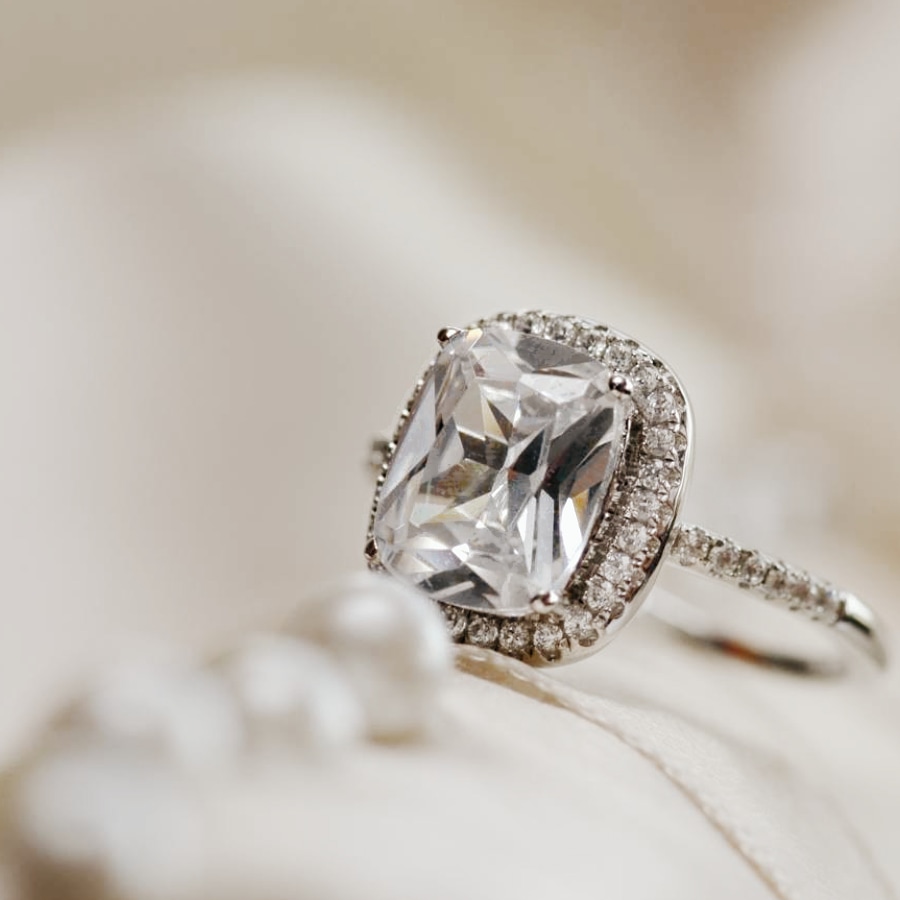
Did you know that “ Diamond Cut” in addition to having square shape, oval shape, heart shape or other basic geometry shapes that we have mentioned previously – there are also many other rare diamond cuts that you might have not heard of.
For typical diamond stores in Thailand, you might find fancy diamond cuts that will generally fall into 1 of these 12 popular diamond cuts. Cuts such as round diamonds, Asscher diamonds, Cushion diamonds, Square diamonds or Princess Diamonds. However, there are hundreds of diamond cuts in the world. The “Rare Diamond Cuts” are hard to find and not often seen.

The reason for its rarity is not because these rare diamond cuts are not popular, but it is because some of the rare diamond cuts are very special. They have been patented and are sold exclusively to some brands, making these rare diamond cuts uncommon and expensive. These rare diamond cuts are also called “Branded Diamond Cut”
My name is Brooke and I will be your guide in this journey of discovering rare diamond cuts, in the case that you are interested in them and your budget allows it – you can try ordering a custom diamond engagement ring with these types of cuts (but you can only order them through a brand that has the legal rights to making these cuts”
In this article, I want to introduce the “9 Rare Diamond Cuts” to you. As for the other cuts and designs, if given the opportunity, I will continue bringing them to your attention. What kind of rare diamond cuts will you like? Let us take a look.
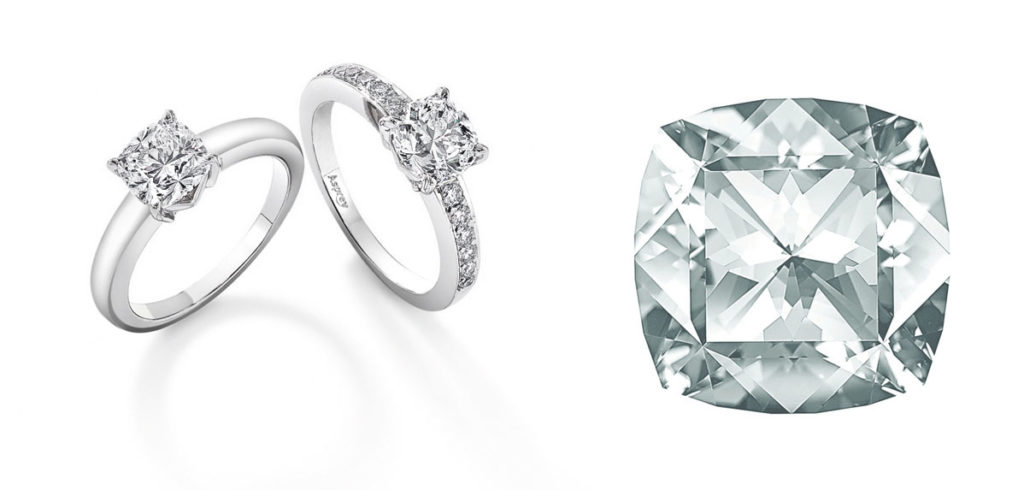
At first glance, the rare diamond cut “Aspret Cut” might seem similar to the square shaped “Cushion Cut”, however – its cutting characteristics are special and are like no other.
The Asprey Cut was designed by one of the world’s most renowned diamond cutter, Gabi Tolkowsky. He studied the history of diamond cuts and fell in love with the “Cushion Cut” in the styles of the 18th and 19th century. The shape of the Asprey Cut is not overly square and has softer edges – the letter “A” is engraved onto the edge, making it this cut’s unique identity.
More than this, Asprey Cuts are only hand-crafted, no machines are involved unlike other diamond cuts.
This fancy diamond is a redesign of the cushion cut, it has been adjusted to look more modern and more brilliant. The reason for its ability to reflect light spectacularly because of its 61 facets.
The Asprey Cut are only used in diamonds with the color grade between D-G, with a clarity level from Flawless to VS2 and the carat weight between 0.5 – 3 carats or more. This is what makes this rare diamond cut even rarer.
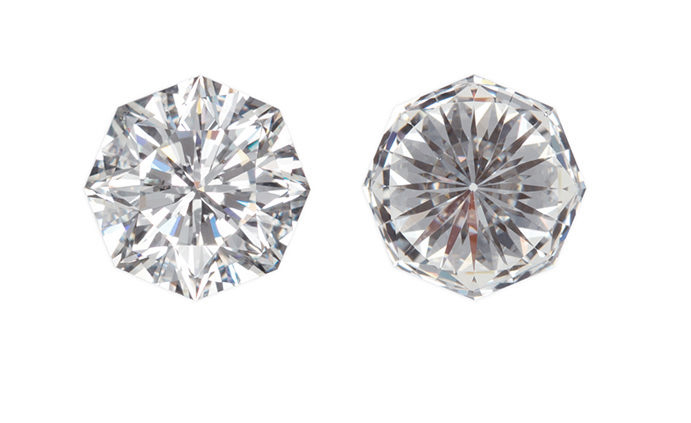
If anyone likes wearing rings for good fortune, the rare diamond cut “Eighty-Eight Cut” is considered the best fit for you. This ring is inspired by the Asian beliefs about the number “8” bringing good fortune. The number “8” in chinese sounds similar to wealth, power and good fortune in life.
The cutting style of the Eighty-Eight Cut is of an octagon. There are 88 facets in total and is designed by the brand “Finesse Diamonds”
This rare diamond cut seems different from the other diamond cuts because of its octagonal shape. It also adds good fortune and has a different sparkle from the typical round diamonds. It can shine brightly even under low-light conditions because of its unique master-level cutting techniques.

The rare diamond cut that is the “Royal Asscher Cut” is an updated Asscher Diamond design which was created by Joseph Asscher in 1902.
In the year 1999 Edward and Joop Asscher, the great-grandsons of Joseph returned to upgrade and change this diamond cut for a more modern look.
Originally, the Asscher diamond had a total of 58 facets. The Royal Asscher has added 16 more facets, another facet layer, a higher crown and a smaller cross-section. The diamond also has perfect symmetry, causing it to shine brighter than the typical square-shaped diamonds. Its clarity is also higher than the round-shaped diamonds.
It can be said that the diamond cut, Royal Asscher Cut, is a true rare diamond. Not just any diamond store can make this diamond cut as there are less than 75 people on Earth that are able to cut this type of diamond perfectly.
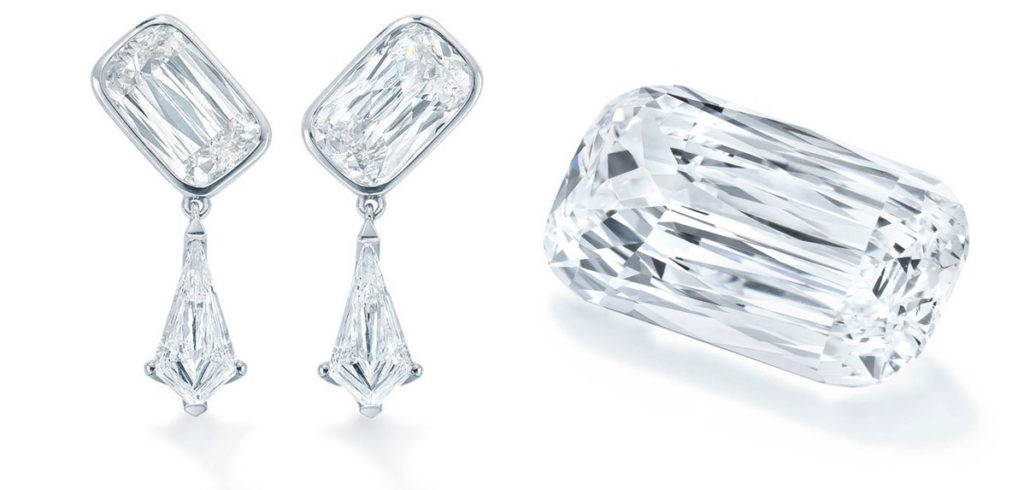
The rare diamond cut “Ashoka Cut” is actually a modification to the Cushion Diamond. It has been adjusted to a rectangular shape with softer edges. It was designed by William Goldberg Diamond Corporation in the year 1999. Its name, Ashoka, comes from the Golconda diamond which weighs 41.37 carat with D Color grade and Flawless clarity. It was discovered in Golconda which is related to “Ashoka the Great” and has been trademarked since the year 2000.
To cut a diamond in the Ashoka Cut style, the diamond cutter must cut the diamond into 62 facets. This style of technique will make the diamond look larger than usual. Cutting a diamond in this style could take over 6 months due to the selection process, the raw diamond must be larger and longer than most diamonds. Diamonds such as these are hard to find and only 10% of raw diamonds match these criterias.

The Jubilee Cut is a vintage rare diamond cut that is not often seen because it is usually only used on larger diamonds which will make the already large diamond shine more brightly and brilliantly.
A Jubilee Cut has a special shape, the important characteristics are its lack of a flat table and its 8 facets at the top. The Jubilee Cut has 88 facets in total.
This diamond was made in the early 20th century to honor the 50th anniversary of Queen Victoria of England.
As this rare diamond cut’s unique characteristic of not having a cutlet as well as a shallow shape.This makes this diamond cut one of the rare diamond cuts that is able to shine most brilliantly and is easily one of the most rare diamond cuts.
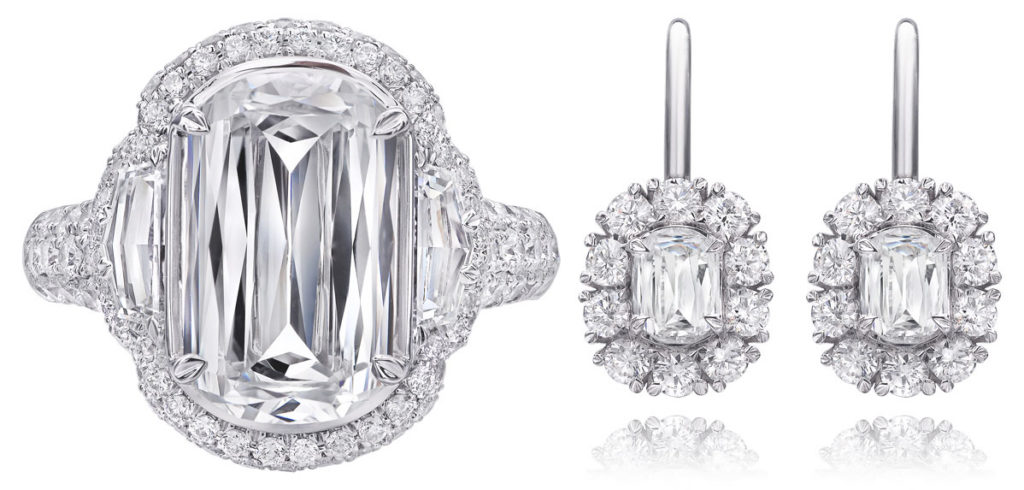
The “Crisscut” is a rare diamond cut that has a unique and unusual facet, it was designed by Christopher Slowinski in the year 1998. This rare diamond cut was born out of a mistake as Chritopher was trying to cut an “Emerald” shaped diamond. He accidentally cut into the diamond, creating a unique texture that is the “Crisscut”.
The Crisscut Diamond has a total of 77 facets, the Emerald Cut has only 44 facets. This technique can be used on the Emerald cut, the Cushion Cut, the Asscher Cut and even round-shaped diamonds.
The defining characteristic of this cut is its facets that “criss cross” each other. This diamond cut’s shine is particularly brilliant and more distinctive than any other rare diamond cut.
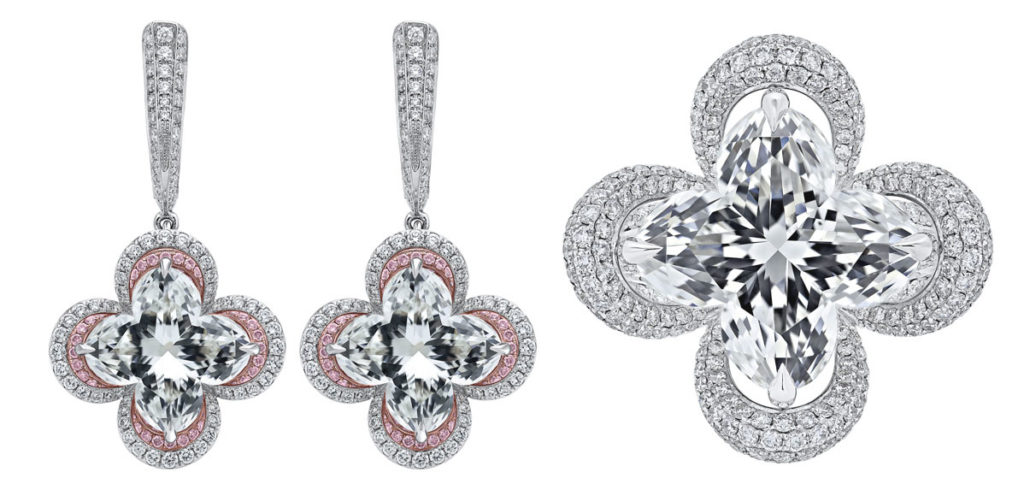
This rare diamond cut is perhaps one of the sweetest and cutest cuts. The diamond is cut into a shape similar to a flower or a 4-leaf clover. The cut was designed by Lili Diamonds of Israel in 2007. This diamond has been used with the renowned French brand, Louis Vuitton which has a unique symbol similar to this rare diamond cut. It has since become a symbol of high fashion.
For this rare diamond cut, there are around 65 facets which resemble a flower. It can be adjusted in 2 ways – a round petal flower or a pointed petal flower.
However, cutting a diamond into this shape will cost a significant amount of raw diamond. The loss of raw diamonds ranges from 25-50%, which is why its cost is also much higher than the other diamonds of the same carat weight.
The PrincessPlus Cut is a much more advanced version of the regular Princess Cut. This rare diamond cut was born in the year 2000 by EFD who is also the manufacturer of the famous Princess Cut diamonds.
The PrincessPlus cut has around 100-115 facets which is much higher than the normal version as the Princess Cut will typically have around 58-68 facets. The finer details appear more frequently in the base and the top of the diamond, making this rare diamond cut shine much more brilliantly than the regular Princess Cut that has upto 20% similarity in its color grade and clarity level.
And if you buy a diamond of this cut, you will also receive a “Light Return Analysis” Certificate which will guarantee you that the diamond’s brilliance is the result of a perfect diamond cutting technique.
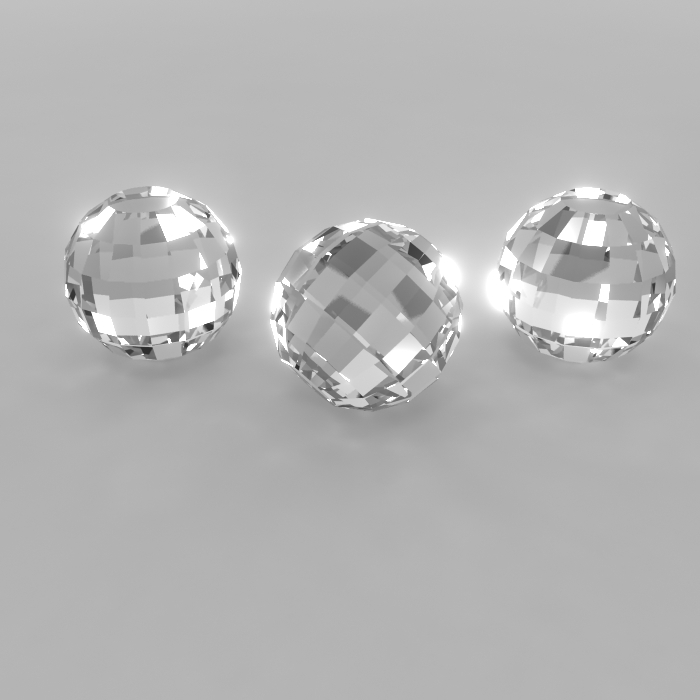 Credit: turbosquid
Credit: turbosquid
Although this is not a Branded Diamond Cut, this rare diamond cut is completely different from all the other rare diamond cuts. The Bead Cut is carefully cut into a shape similar to a disco ball, it is created to be used as a bead. This cutting technique could also be called the “diamond bead” as it could be threaded into a necklace or a bracelet that is like no one else’s.
Bead Cut Diamonds also come in a variety of shapes and sizes, the facets are cut around the shape, there are no tables nor cutlets and is usually cut from a special type of diamond which already has an almost spherical shape.
The most important thing to keep in mind when buying a bead cut diamond is the drill hole which is directly at the center of the bead cut diamond. This hole threading. The hole size must be extremely small because if the hole is too big, the diamond could lose its brilliance and make the diamond look dull and muddled.
“Diamond Cuts”, There Are More of Them Than You Think
Studying beyond just the basics of diamonds is great fun. Even though these diamonds are rare and highly costly, it shows us that Fine Jewelry is an artform in which many artists have tried to invent new and creative ways to make their diamonds standout and shine more brilliantly.
Although the diamonds found in the Thai diamond industry are not considered as rare, you yourself could also create and craft countless engagement rings from the standard diamond cuts. If you are interested in designing a diamond engagement ring and ordering a custom engagement ring in your own style, you can consult our team of diamond experts at Above Diamond.

Get in touch with one of our diamond specialists.
This website use cookies to enhance your experience and providing the best service from us. You can learn more about our use of cookies in Privacy Policy